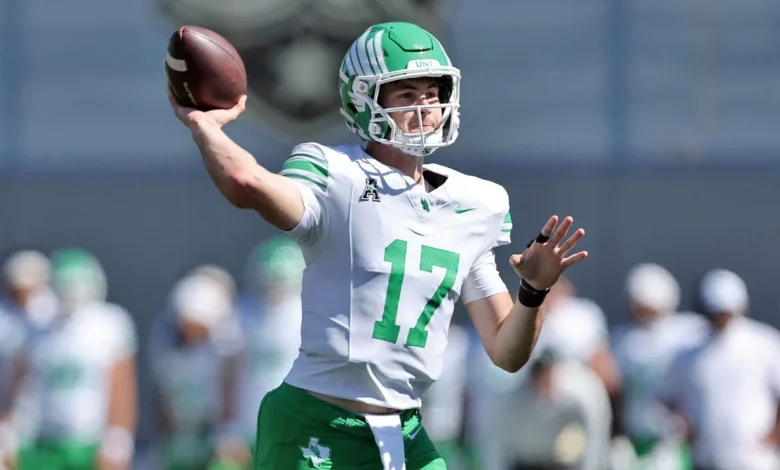How an underfunded Group of 5 program is thriving in revenue-sharing era – The Athletic

DENTON, Texas — Raj Murti had two conflicting thoughts as North Texas raced out to a 3-0 start and budding star quarterback Drew Mestemaker piled up prolific passing stats.
On one hand, there was the joy and appreciation for how well Mestemaker — a former walk-on who was last a full-time starting quarterback on his high school freshman “B team” — was playing. The size, arm talent and playmaking ability made it clear that the Mean Green had something special in the redshirt freshman quarterback.
Then came the fear. The more success Mestemaker has and the more North Texas wins, the more others — particularly general managers and scouting directors at well-funded Power 4 programs — will notice.
“It’s like, not only is he really good, but now we’re winning a lot and it’s only going to garner more attention,” said Murti, North Texas’ first-year GM.
For a Group of 5 program with a roster that costs pennies on the dollar compared to its Power 4 counterparts, as well as many teams in its own league, success is a double-edged sword. The more you win, the more likely your players are to be poached with six- and perhaps seven-figure offers to transfer elsewhere.
North Texas (6-1) is off to its best start since 2018. Led by young, rising coach Eric Morris, the Mean Green are gunning for their first conference championship since 2004.
While Morris, his staff and players try to make history on the field, Murti and Steve Keasler, UNT’s associate athletic director for NIL, are doing everything they can behind the scenes to ensure the Mean Green remain competitive in the future. That means trying to retain Mestemaker and other key players, replenishing the roster if it gets raided and increasing the budget to be more competitive with its conference peers.
“We can’t get in a horse race with some thoroughbreds and we’re on the jackass,” Keasler said. “We’ve got to be on a thoroughbred, too.”
How does a resource-strapped Group of 5 program survive in the revenue-sharing era? Murti and Keasler gave The Athletic an inside look at their process.
North Texas has lost 15 players to Power 4 programs in Morris’ two-plus seasons at the school.
“Not fun,” Morris said. “A lot of sleepless nights and frustration.”
Among the most notable departures are quarterback Chandler Morris (Virginia), offensive tackle Howard Sampson (North Carolina, Texas Tech), guard Febechi Nwaiwu (Oklahoma) and receiver DT Sheffield (Rutgers).
Mestemaker is the next hot target. He had a breakout performance in the First Responder Bowl in December, accounting for 448 offensive yards and three touchdowns. This offseason, North Texas brought in a transfer, former Miami and Albany quarterback Reese Poffenbarger, to compete for the starting job, but Mestemaker beat him out.
Mestemaker has picked up where he left off, throwing for 1,860 yards and accounting for 21 total touchdowns with just five turnovers through seven games. Power 4 programs noticed. After just three starts, at least one SEC team had Mestemaker atop its list of portal targets, according to an agent briefed on that team’s strategy.
Eric Morris is 17-15 in two-plus seasons at North Texas. (Raymond Carlin III / Imagn Images)
“Every single P4 team, if you’re smart, has a ‘poach board’ and it consists of all the top Group of 5 or FCS players,” said Murti, who also worked on personnel staffs at TCU and Houston. “It’s no different for us. We have FCS and D-II players (on ours). Everyone does it. If you don’t do it, you’re behind the 8-ball.”
North Texas went through this last year with Chandler Morris, the former Oklahoma and TCU quarterback who led the American Conference in passing yards and touchdown passes in 2024 in his one season with the program. The Mean Green tried to retain him, but Virginia nearly tripled the offer North Texas could make, Eric Morris said in July. UNT’s offer to Chandler, according to two sources briefed on the offer, was roughly $500,000.
Murti, who arrived this spring, and Keasler, who is in his second year with the program, are looking to be more aggressive in the attempt to retain Mestemaker. Their goal is to raise at least $1 million, which is the typical market rate for a Power 4 starting quarterback. Most compensation numbers aren’t publicized, but according to data from industry sources and various media reports, at least 28 P4 starters are making seven figures this season.
“If you don’t hit seven figures, your realistic chance of keeping him is gone,” Murti said.
Even with that effort, North Texas knows it won’t be the highest bidder. It can’t be. The customary Power 4 program’s baseline roster budget ranges between $13 million to $15 million, and that’s for programs operating within the $20.5 million cap established by the House v. NCAA settlement. Some well-resourced programs that frontloaded NIL deals before the cap kicked in are spending $25 million or more for their 2025 roster.
The Mean Green’s current roster budget is believed to be less than $2 million, according to conference sources briefed on the numbers.
To give themselves a fighting chance, Murti and Keasler are working on other areas to supplement their potential offer to Mestemaker, such as housing and travel costs for his family to attend road games — “all the stuff that you see other programs doing that live above the cap,” Murti said.
They’re making progress on those fronts.
“Whenever we put the whole package together at the end of the season and say, ‘Drew, this is everything we can do for you.’ Is that gonna matter?” Murti said.
Meanwhile, Keasler is working hard to appeal to donors, some of whom may have felt burned in the effort to keep Chandler Morris last year. He’s also lobbying school leadership for additional funding, not just for Mestemaker, but for the entire team.
The roster budgets in the American Conference vary, but the Mean Green are toward the bottom. USF is at the top, with a budget between $8 million and $10 million, at least five times that of the Mean Green, according to three conference sources briefed on the numbers. It showed when the teams played earlier this month, as USF’s offensive and defensive lines were bigger and stronger, wearing North Texas out as the game progressed.
Memphis and Tulane are believed to be not too far behind USF. The roster budget floor in the American Conference is believed to be in the low seven figures. The fact that North Texas is in the conference title mix with scant resources is a minor miracle.
“We have a team that we haven’t spent a lot of money on and we’re (6-1),” Keasler said. “I don’t know that that’s sustainable.”
There’s a scene in the film “Moneyball” where Brad Pitt, who plays former Oakland A’s general manager Billy Beane, asks the owner for more money to acquire players in a world where opposing teams had payrolls more than triple that of Oakland’s.
“I’m not asking you for $10 or $20 or $30 million, I’m just asking for a little bit of help,” Pitt pleads.
This is the world Keasler is living in. After more than 30 years in college and high school athletics, he arrived in Denton last year to oversee NIL and revenue sharing for North Texas’ entire athletic department.
Football takes up the most time. His primary goal is to ensure UNT isn’t being lapped by its competition. Just because the Mean Green are winning on the cheap now doesn’t mean it’s replicable. Mestemaker is akin to an NFL quarterback on a rookie contract.
“There’s not very many Drew Mestemakers out there that start on zero (compensation) and play the way he played,” Keasler said.
He works hand-in-hand with Murti to ensure every dollar is carefully allocated. When the budget is tight, mistakes can be catastrophic.
Murti said that North Texas is paying revenue-sharing money to roughly three-quarters of the 85 players on scholarship, with around 20-plus who are there on scholarship only. At P4 programs, it’s not unusual for every player to receive some NIL dollars.
For the players who are getting extra, North Texas’ model is based on how NFL teams allocate salary cap money, with quarterbacks, offensive tackles and defensive linemen receiving the most, with some exceptions. That’s standard practice across college football.
Every week, Murti assesses the current roster talent based on coaches’ feedback in staff meetings and film review and adjusts his projections for 2026 accordingly. In addition to Mestemaker, Murti estimates at least a dozen other players could be targeted by Power 4 programs. And it’s not just starters.
“If a player’s got size, frame, speed and he’s sitting behind a senior, but he’s really freaking good, I worry about keeping him, too,” Murti said. “Most of the starters, we’re going to be pennies on the dollar to what a P4 school can pay.”
UNT’s independent NIL collective shut down as revenue sharing kicked in, so Keasler helps coordinate third-party deals. Most of them are in the hundreds of dollars and are run through NIL Go, the clearinghouse set up by the newly formed College Sports Commission. Some may be bigger, like what they’ll attempt to do for Mestemaker.
Every little bit helps. This spring, Eric Morris approached Keasler about a fundraiser in which he would match pledges from donors, with the money going to the Green Lights Fund, an in-house NIL and marketing fund for the football team. The “Morris Family $50,000 Challenge” was successful enough that North Texas pushed the goal to $75,000, which was also surpassed. It also bought some goodwill. “It has done wonders for me in conversations with our donors,” Keasler said, because Morris put up his own money.
Morris said that in his time at UNT, he has developed close relationships with multiple donors and feels comfortable reaching out to them directly to help the program.
“I’m trying to take a little bit of the responsibility (for funding the roster),” Morris said. “Let’s close this gap the best we can, little by little.”
Evaluation remains of paramount importance. Murti oversees a personnel staff that is taking a fine-toothed comb to the Texas high school ranks to find the next stars North Texas will develop, while also scouring the transfer portal for Power 4 bouncebacks as well as FCS and even Division II stars to replenish the roster. They’re not just trying to replace the roster — they’re trying to upgrade it.
The strategy, as Morris explains it, is to limit mistakes when the Mean Green spend money while continuing to recruit quality freshmen that they can develop.
The margin for error is small, and misses are costly.
“We can have all the money in the world,” Keasler said. “But if we don’t have the right players, we’re going to have a sh—y team.”
As the team continues to pursue a championship, big decisions loom. In addition to the inevitable bidding war for Mestemaker and other key contributors, Morris will also be a hot commodity. Arkansas and Oklahoma State, Power 4 programs in neighboring states, both have openings and are likely to at least vet Morris as a candidate.
Other Power 4 jobs will open, and Morris’ track record as a head coach — at UNT and FCS Incarnate Word — and a successful P4 coordinator are attractive. So is his knack for finding and developing quarterbacks, including 2025 No. 1 NFL Draft pick Cameron Ward.
Skyler Cassity, UNT’s first-year defensive coordinator who arrived from Sam Houston, could also get some looks. He did wonders at his previous stop and has overseen major improvements to a North Texas defense this year that was often the team’s Achilles’ heel in 2024.
And if a Power 4 program tries to scoop up Morris, that school could also target Mestemaker and Cassity. On Monday, the school’s board of regents authorized athletic director Jared Mosley to negotiate a contract extension with Morris, so the Mean Green are doing what they can.
WE’RE GOING BOWLING!#GMG🦅 | @BowlSeason pic.twitter.com/qQGk2veTT1
— UNT Football (@MeanGreenFB) October 18, 2025
In Keasler’s mind, keeping that trio in Denton is paramount.
“If we keep Morris, we keep Drew and we keep Skyler, all the other stuff’s gonna take care of itself,” he said.
As for Mestemaker, Keasler said they’re trying to make it worth his while to stay and “give him what he deserves.” Keasler spent the last month talking to potential donors and also preparing himself for the conversations if money is committed and Mestemaker leaves.
And they won’t fault him if he does. If a power program swoops in with an offer that approaches the top of the market, between $2 million and $3 million a year, “you give him a hug and tell him good luck,” Murti said.
“If Drew wants to go play at the highest level, how do you blame him?” Murti said. “It’s tough as a competitor to tell another one to not do that.”
But Keasler and Murti believe that if the quarterback stays, it would be a boon to the rest of the roster.
“You keep (Mestemaker), maybe that receiver doesn’t leave for $250,000 and stays here for less, because it’s another year with his quarterback and this offense,” Murti said. “Drew’s a captain, people want to rally around him.
“In my eyes, if we keep our quarterback, that helps with everyone else.”
Morris has learned to cope with the frustration of North Texas’ position on the college football food chain. Instead of belaboring it, he’s trying to solve the problem with the limited resources available, while scratching and clawing for more.
“You’re not gonna be on the same level ever (as the Power 4 schools),” Morris said. “But if we can keep a couple of these guys every year, it’ll be good for our program moving forward.”





